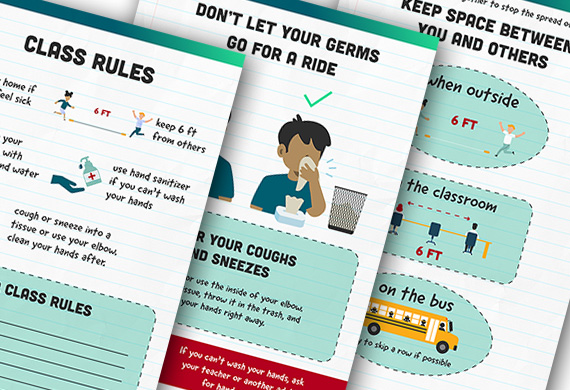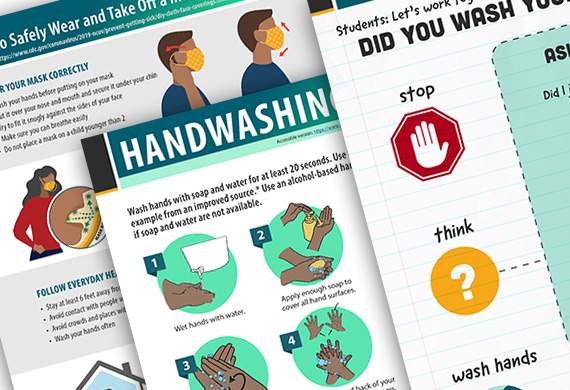Prevent confusion, illness, and misinformation from disrupting your school’s gradual return to in-person learning. Adapting your school’s processes and safety protocols in concert with clear and informative signage will help improve your students health and safety.

clashgraphics.com gathered the following information about suggested COVID-19 school safety protocols, how schools can implement strategic signage to encourage their students to follow OSHA and CDC protective safety guidelines.
CDC Schools Reopening Guidelines
The Centers for Disease Control and Prevention (CDC) issued guidelines/considerations to help schools reestablish in-person learning while protecting the health of students, teachers, staff, their families, and communities. These considerations include:
- Promoting behaviors that reduce COVID-19’s transmission
- Maintaining healthy school operations
- Maintaining healthy school environments
- Preparations for when someone gets sick
There exists, within each community, unique needs and circumstances. The implementation of health and safety guidelines should be guided by their feasibility, practicality, acceptability, and tailored to the community’s needs.
Note: These considerations are intended to supplement - not replace - Federal, state, local, territorial, or tribal health and safety laws, rules, and/or regulations with which schools must comply.
1. Promoting Behaviors That Reduce COVID-19’s Transmission
Changing behaviors in our communities plays a crucial part in successfully returning to in-person learning, sports, and other social activities. These behaviors include:
- Staying home when sick
- Social distancing - staying 6 feet apart
- Wearing a mask (especially when social distancing is difficult or entering in closed spaces)
- Avoid touching eyes, nose, and mouth
- Covering your cough or sneeze with a tissue (then disposing of the tissue in the waste bin)
- Hand washing
- Frequent hand sanitizing
In an educational setting, constant reminders like signs, monitors, and extra staffing can be used to help others permanently alter their behavior.

2. Maintaining Healthy Operations
School administrators can make changes in the way they manage their schools to support and maintain healthy operations. Some of these changes include:
Measures to protect high-risk staff, teachers, and students
- Enact policies (following applicable local, state, and federal law) to protect all individuals’ privacy at higher risk for severe illness regarding underlying conditions.
- Provide limited exposure, work from home, and modified job responsibility options for teachers and staff at risk or with underlying medical conditions.
- Provide virtual learning opportunities for students at risk or with underlying medical conditions.
- Create and provide inclusive school programming for students with special physical needs, healthcare needs, and disabilities, allowing virtual or on-site class and activity participation with necessary assistance, modifications, and accommodations.
Further changes to consider:
- Dividing teachers and students into groups and keeping those groups together.
- Hybrid options - alternating schedule for remote learning and in-person learning.
- Stagger student arrival, drop-off, and pick-up times to prevent or limit over-crowding and contact with parents, caregivers, and guardians.
- Designate one staff member (school nurse) as the COVID-19 point of contact. This staff member should be known and accessible to students, teachers, staff, and families.
- Implement more relaxed absence and leave policies to accommodate staff, teachers, and students staying home when sick, exposed, or caring for someone who is sick.
- Create a back-up staffing plan to temporarily cover staff absenteeism.
- Hold frequent training sessions with staff and teachers covering safety protocols, COVID-19 updates, recognizing signs and symptoms, and how to handle a situation when someone gets sick.
Watch this video from the CDC on protecting students, staff, families, and communities from COVID-19.
3. Maintaining healthy school environments
School administrators can make changes in providing and supporting a healthy environment for staff, teachers, and students. Some of these changes include:
- Require universal mask use.
- Increasing the frequency of cleaning and disinfecting surfaces throughout the school (door handles, desks, sink handles, vending machines, drinking fountains, etc.
- Train and ensure the correct usage and storage of cleaning and disinfection products (these products should meet Environmental Protection Agency (EPA) disinfection criteria)
- Discourage item sharing (devices, toys, learning aids, books, writing utensils, etc.).
- Upgrade, improve, and increase maintenance frequency of the ventilation system to deliver clean air and filter or dilute potential contaminants.
- Require or increase outdoor air ventilation by opening doors, windows, vents, and using fans to increase open door and window efficiency.
- Flush plumbing system and open faucets to run water (this ensures water safety after prolonged periods of shutdowns or inactivity.
- Modify seating/desk arrangements and positions to maintain students 6 feet apart (this includes classrooms, lunch/community areas, buses, and transportation alternatives).
- Install sneeze guards and partitions in locations that make it challenging to remain 6 feet apart (restroom sinks, reception desks, etc.)
Watch this video from the CDC on maintaining a healthy school environment.
4. Preparations for when someone gets sick
Schools should be prepared for when staff, teachers, or students come down with symptoms of or receive a diagnosis of COVID-19. Consider the following preparatory steps and isolation/quarantine criteria:
- Anyone with COVID-19 should not return to in-person activities until meeting the CDC’s criteria to discontinue home isolation. Read more on this criteria at cdc.gov/coronavirus/2019-ncov/if-you-are-sick/end-home-isolation.html
- Those who have been exposed to the virus should not return to in-person activities until finishing their quarantine.
- Educate staff, teachers, and students on when to stay home
- Isolate and transport those who develop symptoms of COVID-19.
- Clean and disinfect areas used by a sick person. It is recommended to wait for 24 hours before cleaning and disinfecting or as long as possible when 24 hours is not feasible.
- Immediately notify health officials, staff, and families of any case of COVID-19. Certain measures of confidentiality must be maintained in accordance with the Americans with Disabilities Act (ADA), Family Educational Rights and Privacy Act (FERPA), and all other applicable laws and regulations.
- Inform and educate individuals who’ve had close contact with a person who has tested positive for COVID-19 again, maintaining confidentiality as required by the ADA and FERPA.
- Develop a building, facilities, and event closure procedure that activates if/when an infected person (during their infectious period) has been on campus or has had close contact with others.
Note: In the event, your school must close, communicate with your local public health officials to coordinate the extent, duration, and next steps for activity suspensions and cancellations.
Watch this video from the CDC about schools having a plan for when someone gets sick.
OSHA Guidance for the Workplace
The following is a summary of what to know about COVID-19 protection in the workplace, tailored for teachers and school staff:
- One of the best ways to protect yourself is to maintain enough distance from other people, so you are not breathing in particles produced by an infected person – at least 6 feet.
- Wash your hands often. Always cover your mouth and nose with a tissue or inside of your elbow when you cough or sneeze. Monitor your health daily and watch for COVID-19 symptoms.
- Use face coverings. These are simple barriers to help prevent the exchange of respiratory droplets or aerosols. The CDC recommends that face coverings be made of at least two layers of tightly woven breathable fabric, without exhalation valves or vents.
- The principal function of properly wearing a face covering is to shield or protect those around you in case you are infected without symptoms.
- You should use face coverings whether you are showing symptoms or not. People with COVID-19 who do not develop symptoms (asymptomatic) and those not yet showing symptoms (pre-symptomatic) can still spread the virus.
- Even if you have been vaccinated, it is essential to wear a face covering, maintain distance, and abide by other safety measures. It is not yet known how vaccination affects transmissibility.
- Follow established COVID-19 prevention programs that include steps to keep staff, teachers, and students safe – including flexible schedules, personal protective equipment (PPE), and face coverings.
For more of OSHA’s guidance on mitigating and preventing the spread of COVID-19, visit osha.gov/coronavirus/safework
Social Distancing Signs for schools
Providing a safe learning environment is reliant on having a strategy and how it is implemented. That strategy should include directional and educational signage strategically posted throughout the school.

The CDC developed the following signs and informative handouts for COVID-19 awareness to continuously remind students to wash their hands, maintain 6-feet between themselves and friends, wearing a mask, etc.
- Cover Coughs and Sneezes (children)
- COVID-19 Class Rules
- COVID-19 Don't Let Your Germs Go for a Ride
- COVID-19 Keep Space Between You and Others
- COVID-19 Did You Wash Your Hands
- Wash Your Hands
- How to Safely Wear and Take Off a Mask
- Infographics for Parents
- Infographics for School Nurses
- Infographics for Teachers
- Respiratory Hygiene - Cover Your Cough
- What to Do If a Student Becomes Sick - Flowchart
Tip: You can customize these signs and infographics with your school’s mascot, logo, or motto.
Visit the following links for more CDC guidance for schools:
- K-12 Schools COVID-19 Mitigation Toolkit cdc.gov/coronavirus/2019-ncov/community/schools-childcare/FINAL-0321420_B_K-12_Mitigation_Toolkit508.pdf
- How Do I Set Up My Classroom cdc.gov/coronavirus/2019-ncov/downloads/community/schools-childcare/How_Do_I_Set_Up_My_Classroom.pdf
- Teachers and Staff Resuming In-Person Learning cdc.gov/coronavirus/2019-ncov/downloads/community/schools-childcare/Teachers_and_Staff_Resuming_In-Person_Learning_checklist.pdf
Note: As more research and patient data is collected, the above guidelines and recommendations may be modified to address virus mutations, increasing infection rates, vaccination efficacy, and other emergent data.
CDC Guidelines for Schools
In this article, you discovered valuable information about COVID-19 school reopening and safety protocols, a school’s use of signage to influence and guide students, and essential guidance from the CDC, OSHA, and NIH.
Implementing a school reopening strategy that protects students, teachers, and staff creates a safe, organized, and nurturing environment to resume in-person learning.
Without good planning, guidance, and informational signs, many children and some adults are likely to forget or not follow safety guidelines. It only takes one person to cause another outbreak.
Sources:
cdc.gov
niaid.nih.gov
epa.gov/pesticide-registration/list-n-disinfectants-coronavirus-covid-19
health.harvard.edu/diseases-and-conditions/preventing-the-spread-of-the-coronavirus
eeoc.gov/facts/pandemic_flu.html
www2.ed.gov/policy/gen/guid/fpco/ferpa/index.html
Clash Graphics Print Shop Atlanta Flyer Printing
2233 Peachtree Rd NE Ste 202 Atlanta, GA 30309
(678) 235-3464
To view the original version on Clash Graphics, visit: https://www.clashgraphics.com/printing-tips/social-distancing-in-schools/